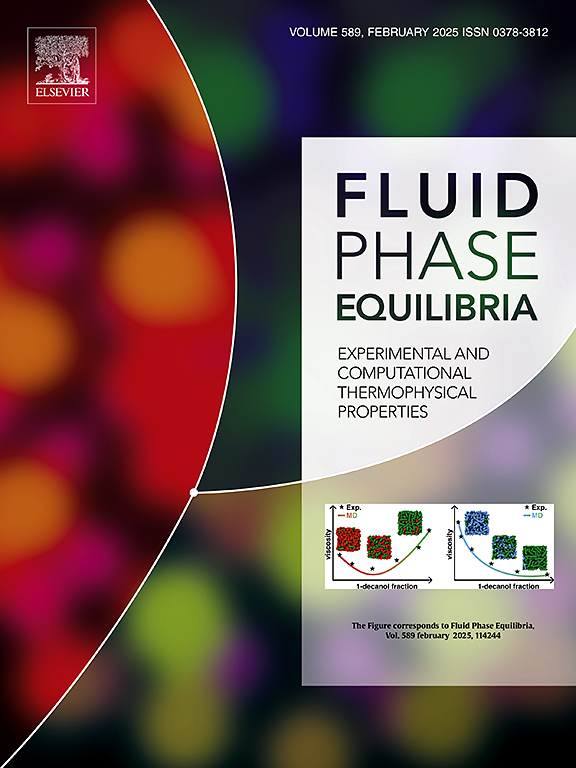Estimation of mixture viscosity of ionic liquids using cubic two state equation of state and Eyring theory
IF 2.8
3区 工程技术
Q3 CHEMISTRY, PHYSICAL
引用次数: 0
Abstract
In this work the Cubic two State (CTS) equation of state (EoS) has been utilized to model the pure and mixed ionic liquids (ILs) viscosity. The free volume theory (FVT) and Eyring theory have been coupled with the CTS EoS to estimate the pure and mixture IL viscosity. The average relative deviation (ARD%) of pure imidazolium-based ILs viscosity has been obtained 0.42 %. The results show that the CTS+FVT can estimate the pure viscosity of ILs up to high pressure accurately. The mixture viscosity has been calculated using the CTS coupled with the Eyring theory and Redlich-Kister mixing rule. In this regard, four adjustable parameters of the thermal contribution of excess activation free energy in the Redlich-Kister mixing rule have been adjusted using the experimental viscosity data. The average ARD% value of mixture viscosity has been obtained 3.6 %. The effect of ideal, thermal, and mechanical contributions of excess Gibbs free energy of the Eyring theory on mixture viscosity has been studied. The results show that the thermal and mechanical terms have a minor effect on mixture viscosity. The CTS model results have been compared to the SAFT-VR Morse EoS. The result shows that a simple and robust model like CTS can be utilized as an alternative model for complex SAFT-based models to estimate the pure and mixture viscosity of IL-containing systems.

求助全文
约1分钟内获得全文
求助全文
来源期刊

Fluid Phase Equilibria
工程技术-工程:化工
CiteScore
5.30
自引率
15.40%
发文量
223
审稿时长
53 days
期刊介绍:
Fluid Phase Equilibria publishes high-quality papers dealing with experimental, theoretical, and applied research related to equilibrium and transport properties of fluids, solids, and interfaces. Subjects of interest include physical/phase and chemical equilibria; equilibrium and nonequilibrium thermophysical properties; fundamental thermodynamic relations; and stability. The systems central to the journal include pure substances and mixtures of organic and inorganic materials, including polymers, biochemicals, and surfactants with sufficient characterization of composition and purity for the results to be reproduced. Alloys are of interest only when thermodynamic studies are included, purely material studies will not be considered. In all cases, authors are expected to provide physical or chemical interpretations of the results.
Experimental research can include measurements under all conditions of temperature, pressure, and composition, including critical and supercritical. Measurements are to be associated with systems and conditions of fundamental or applied interest, and may not be only a collection of routine data, such as physical property or solubility measurements at limited pressures and temperatures close to ambient, or surfactant studies focussed strictly on micellisation or micelle structure. Papers reporting common data must be accompanied by new physical insights and/or contemporary or new theory or techniques.
 求助内容:
求助内容: 应助结果提醒方式:
应助结果提醒方式:


